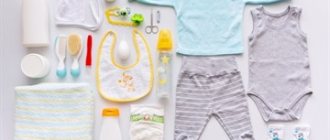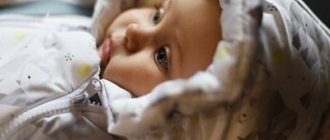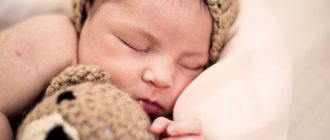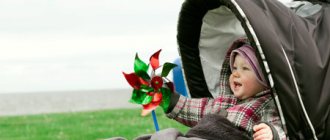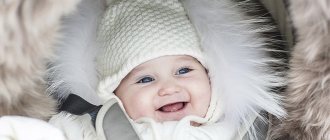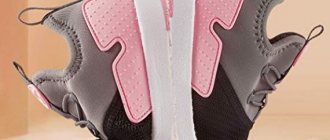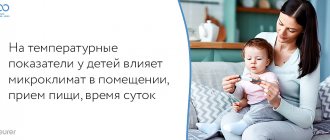01 October 2016
Averyanova Sveta
Autumn is an unpredictable time of year. The sub-zero temperature changes to positive in a few hours, the sun shines brightly, but gives almost no warmth. Rain and wind add to the unpleasant sensations for children while walking. Parents are faced with a difficult question: how to properly dress their child outside so that he does not get cold or sweat? Let's talk about this topic.
Useful tips
When taking children for a walk in the fall, it will be useful for parents to follow some tips:
- Prepare clothes for yourself and your baby in advance, taking into account all the little things for the walk (hats, scarf, gloves, spare pants). Often mothers, just about to leave the house, remember that they forgot their mittens and cap. Finding things takes a lot of time, and the dressed baby sweats.
- Dress yourself first, then gather your child.
- If you decide to stop by the supermarket on the way home from the playground, take off your baby’s hat, scarf and unbutton his jacket indoors. This will protect the little one from overheating, sweating and blowing through a wet body.
- Don't be afraid of lightweight synthetic membrane jackets with special insulation. Such things are warm and free. Thickness and multi-layered outerwear are not a sign of its comfort or practicality for walking in the cold season.
- Focus on the readings of the outdoor thermometer, the strength and direction of the wind when choosing a set of clothes for walking.
- The frost resistance of adults and children is very different. One-year-old babies feel warmer than moms and dads. Therefore, you should not compare your feelings with children’s.
- To determine if the baby is cold, touch the bridge of the nose, neck and hands.
If the neck is wet, then the child is hot, you put a jacket on him that is too warm, it was in vain to cover him with a blanket in the stroller. If it’s cold, then you need to go home and change clothes. - Red cheeks and nose are not reliable indicators of a baby’s well-being. Blush may appear due to active running or climbing, which indicates good health.
- Early autumn is characterized by rapid weather changes, so a jacket, hat and scarf should be at hand when walking.
- Clothes for autumn for children should correspond to the age of the child and his activity. If the baby is six months old and does not walk yet, then dress him warmer for a walk than a three-year-old child. For an actively running preschooler, choose light clothes so that he does not sweat while playing in the yard.
- Before changing clothes to go outside, look out the window. The example of passers-by will help in choosing a suit. Pay special attention to children's clothing in the yard.
- Have an educational conversation with grandmothers who are panicking from a light breeze. Insist on your own rules for dressing your baby outside. Accompany each outing with clear instructions: when to put on an extra jacket, whether to take off a hat, unbutton a jacket, or cover a cold baby with a blanket. If you don't do this, your two- to three-month or six-month-old baby will be bundled up to the eyes even in hot weather.
Important information! Young parents, and especially overly caring grandmothers, are afraid of overcooling their baby, so they put on the warmest jacket, two scarves and a sweater.
As a result, the baby overheats, and this is no less dangerous for children's health.
How to dress for discharge?
Now about how to dress a newborn for discharge in the summer. When choosing clothes for discharge, consider the outside temperature.
Plus, don’t forget that after the maternity hospital you will immediately go home and will not be on the street for a large amount of time.
In addition, most likely, you will be traveling by car, where the temperature will definitely not be lower than the street temperature.
Here are several options for clothing for a baby to be discharged in the summer. They are given taking into account the outside air temperature.
You can create your own kit, taking into account the factors that I mentioned above.
- 25 degrees and above - light overalls, a headdress and a light diaper in which the baby or summer envelope will be wrapped.
- 20–23 degrees - add another bottom layer to the above set in the form of a vest or T-shirt.
- Below 20 degrees - the bottom layer in the form of overalls, a thick suit, a summer envelope.
If on the way home you feel that you have overdone your clothes, take off one layer.
Table of clothing depending on temperature
During the autumn period, the air temperature outside during the day ranges from +15 to -10°C. To dress your child correctly, you can use this handy reminder. (Important! The table can be scrolled left and right on your phone).
| Outdoor temperature | Features of weather conditions | What things to buy |
| From -8°C and below | • At this temperature, wind and even snow are possible. If its gusts are strong and the direction is north, it is better to postpone going outside or reduce the duration of the walk to 30 minutes. • Newborns should not go for walks on this day. Infants under 3 months have a weak nasopharynx and colds are possible. • When walking in a stroller, use a warm cover. It will close the entrance for cold air inside. • Bring a blanket or shawl with you. • Place a warm blanket under the infant. | The child needs to be dressed warmly. The following set is suitable for newborns: 1. thin bodysuit; 2. insulated slip; 3. winter overalls with closed legs; 4. thin cotton cap + thick hat with sheep wool lining; 5. wool socks + insulated booties. For babies over one year old you will need: 1. tights; 2. tight pants with fleece; 3. T-shirt; 4. T-shirt; 5. a sweater, preferably with a high neck to cover your neck. 6. jacket made of waterproof fabric with a hood; 7. demi-season hat, beret; 8. Insulated sneakers, warm boots. |
| From 0 to -8°С | • The weather on such days is very changeable. It will be warm in the sun and cold in the shade. • If the mother dressed the baby in winter overalls, then it is better to choose the shady side for walks; if it is autumn, then the sunny side. • Walk newborns for no more than 40 minutes. For children over one year old – 1 hour. • Get a stroller cover. It will protect the baby from wind and rain. • Apply protective cream to the baby's face. | We dress the infant: 1. cotton slip or bodysuit; 2. thermal underwear or knitted suit (pants and blouse); 3. thin cap; 4. winter hat; 5. wool socks; 6. an envelope with winter insulation or a jumpsuit with closed legs. For children after one year, the following set of clothes is considered suitable: 1. underwear (T-shirt); 2. long sleeve T-shirt; 3. sweater; 4. tights; 5. insulated jeans; 6. sneakers, waterproof boots. |
| From +1 to +8°С | • You can walk without wind and rain for 2 hours. • Bring a light blanket in case the wind picks up. | For newborns you will need: 1. bodysuit; 2. warm slip; 3. autumn jumpsuit or envelope; 4. light cap and knitted fleece hat; 5. fur booties. We dress children over one year old: 1. T-shirt; 2. knitted sweater or turtleneck; 3. warm pants or light ones if you have cotton tights; 4. light autumn jacket; 5. hat without insulation; 6. autumn boots, sneakers. |
| From +8 to +10 (15)°С | • Warm autumn weather. • In the sun without wind, the child may feel hot. • Make sure that the overalls and jacket are unbuttoned, and that there is a spare light hat in the stroller. • Take a knitted sweater or blanket for a walk. This will help keep your baby warm and change him into lighter clothes if it gets too warm. • You can walk for 2–3 hours. | We dress a baby up to one year: 1. cotton body sleep; 2. warm slip; 3. thin overalls; 4. socks; 5. thick cap; 6. light hat. We dress a child older than one year: 1. T-shirt; 2. windbreaker; 3. jeans; 4. sneakers. |
Important! The heat resistance of overalls for children can be determined by the density of the insulation. With a weight of up to 50 grams, outerwear is considered light - autumn; 150 grams – suitable for temperatures from 0 degrees to +8, for autumn and spring; from 250 grams – winter clothes.
You may also find these videos helpful:
How to dress a newborn for a walk in the fall
Children in the first days and months of life need to breathe fresh air more often, since it is this that helps the lungs and the respiratory system as a whole develop. Pediatricians recommend accustoming a baby to daily exercise from the 5th to 7th day of life. The main thing is to choose the right time and clothes. In autumn, the sun's rays are no longer so active, so at this time you can allow yourself to walk before and just after noon. A stroller with high sides and a protective canopy is best suited for this. If it is not possible to go outside, a balcony can replace it.
The most comfortable way to dress a newborn is in overalls sewn in the shape of a cocoon. Here you don’t need to suffer trying to insert your baby’s arms and legs into the sleeves and trouser legs. In addition, this design allows the child to actively move, which is necessary for normal heat exchange. If the baby is transported in a car seat, it is better to choose a onesie with separate legs.
In addition to outerwear, you will need a hat for a walk in the fall. It is better to dress the child in a hat with wide and soft ties that will not rub delicate skin. It is better to avoid models with large pompoms and without ties.
How to tell if your baby is warm or cold
You can determine whether your baby is dressed correctly for a walk as follows:
- Feel the child's neck, chest, nose, cheeks.
- Pay attention to the child's blush and mood.
- Check the dryness/moisture of the hair under the cap.
Now evaluate the inspection result:
- The baby is cold if his cheeks are pale, water is flowing from his nose (clear sniffles), the baby is capricious, cannot sleep, his chest and neck are cold.
- The baby is hot if he is not in the mood, the hair under the hat is wet, the cheeks are covered with an unhealthy blush, the back is damp.
- The child is comfortable, and the mother has coped with the task of dressing, if the baby is cheerful, the body is warm, the nose and cheeks are cool.
Important! If you notice that you made a mistake with the suit, don’t be too lazy to return home and change your baby’s clothes.
Factors to consider when choosing winter clothes for newborns
When choosing winter clothes, you need to pay attention to the following important indicators.
Waterproof, airtight
To prevent clothes from getting wet and letting steam through, it is important to choose the right material. The water resistance indicator is also reflected on the product tags. Water resistance starts from 3000-5000 mm. In clothes made from such fabric, a baby can easily run through snow and puddles, and he will not get wet. The highest degree of water resistance is 5000-10000 mm and above.
A good indicator of air permeability is from 5000 g/m2/day. The higher this indicator is, the better. However, it is worth understanding that for infants, as well as children who are in a stroller without moving, an indicator of 1000-1500 g/m2/day is suitable. It is only important that their clothes have a lot of insulation. Membrane fabrics best protect against water and wind.
Wear resistance
This indicator will be important for those children who are just starting to walk. Usually their knees and butt are very worn out, so these parts of the clothing will need to be strengthened. The bottom of sets/overalls should ideally be made of denser materials. For example, a fabric such as kondura is often used.
Kondura is a thick nylon fabric coated with polyurethane. The fabric is highly durable and has good water-repellent properties. Teflon impregnation allows for high wear resistance.
Clasps
As mothers write, fasteners should be strong and few in number. The ideal option for babies is a combination of zippers and buttons.
Decor
It is best to choose clothes with a minimum of decor. All these elements are unsafe for the baby. They also create inconvenience when dressing/undressing a child.
What to take with you on a walk
Above-zero temperatures in autumn can quickly drop to zero and vice versa.
Moms need to stock up on this case with the following list of things for walking:
- Blanket, thin blanket. They can be used to cover the child or make a protective curtain from the wind in the stroller.
- Raincoat, umbrella for mom.
- Waterproof stroller cover.
- Wet wipes, handkerchief.
- Water.
- A diaper or towel to sit with your baby outside for breastfeeding.
- On cold days - a stroller; in warm weather - a sling scarf, for babies from 6 months - hipsit.
- At home and on the street during long walks - children's sunscreen, on frosty days - to protect the face and hands from the cold.
Important! Place a bag of spare things in your stroller or walking bag and don’t forget them at home until stable sub-zero temperatures are established, when a thin blanket and umbrella are no longer needed.
Rules for the first walk with newborn children in summer and winter
When can you go out with your baby for the first time, how should you walk with a newborn, How long should the first walk last? Every young mother always asks her doctor these questions. Perhaps there is no disagreement among pediatricians on the issue of walking with a newborn child.
The first walk with a newborn in the summer can take place as soon as the baby is ten days old - he is already ready for his first trip. And although the journey does not pretend to be long or long, it is a serious event for mother and baby.
The first walk with a newborn is not so much a routine moment for the child, but an occasion for the mother to appear before the whole world in a new capacity. A feeling of pride and importance will overwhelm you when you first step out into the yard, pushing a stroller with a precious bundle in front of you and responding to the greetings and congratulations of your neighbors.
For the first walk with newborn children, it is enough to spend 10-15 minutes outside, no matter how good the weather is. Fresh air is not as important for a baby now as constant close contact with his mother, which he is deprived of while in a stroller on the street. And a mother who has not fully recovered from childbirth feels better in a familiar home environment than under the prying eyes of strangers.
Establishing a close bond between mother and child requires silence and privacy, as well as frequent breastfeeding, which is very problematic during a walk. Therefore, until the child reaches 1.5 months of age, spending time in the fresh air should not be frequent or prolonged. According to the rules for walking with newborns, it is enough to go out for 20-30 minutes 2 times a day so that the baby gets used to the new conditions and the mother can unwind from constant worries.
In the future, the duration of walks will increase, but not indefinitely. Twice a day for 2 hours is quite enough for a child in urban conditions.
If you feel regret about the length of walks to the detriment of endless household chores, having a balcony or loggia in your apartment will help you out. Position the stroller so that you can see the baby's face through the glass and hear his cry when he wakes up. A grown-up baby who can sit down on his own, much less stand up, cannot be left in a stroller unattended. The grandmother barely had time to grab one of these restless ones by the legs when he woke up, stood up in the stroller and leaned over the balcony railing.
How to walk with a newborn so that walks bring pleasure to both mother and baby? Choose a convenient place for walking away from crowded streets and polluted highways. You will be hospitably welcomed and sheltered from the city noise by the shady alleys of parks and boulevards, and the nearby pond will protect you with coolness on a hot summer day. Avoid courtyards where cars scurry around, poisoning the air with exhaust gases and the noise of running engines.
So that time does not seem wasted, use it for the benefit of your health: gymnastic exercises, brisk walking and light jogging will help you regain your girlish figure, and a long stay in the air will improve your complexion and mood.
If a child was born in winter, then his first “outing into the world” should take place in the 4th week of life. The first walk with a newborn in winter should take place at an air temperature of at least -5 ° C. If the weather is harsh, then accustom your child to cold air gradually by taking walks in the room with the window open or on a closed veranda.
In the warm season, the child can be outdoors for most of the day, enjoying the gentle sun and the opportunity to get rid of excess clothes. If you spend the summer at the dacha, let the baby be outside from morning to evening. And this time is ideal for hardening.
Let the baby remain undressed for several minutes if the air temperature is not lower than +20 °C. Air baths can be taken 2-3 times a day, gradually increasing their duration to 15-20 minutes.
When taking your newborn out for the first time in the summer while sunbathing, be careful. An infant should not be exposed to direct sunlight; he will feel much more comfortable in a lace shade.
A premature baby, regardless of the time of year, will spend the first month at home, and will go for a walk when he gets stronger and gains at least 3 kilograms of weight. On warm summer days, the duration of walks will gradually increase from 15 to 45 minutes 2 times a day. And in winter, the first walk with a newborn in winter will take place in calm weather at an air temperature of at least -5 ° C. For the first time, it will be enough to spend 10 minutes outside. As the baby gets used to the cool air, the walking time will increase.
If it's warm and raining
Warm and rainy autumn begins in September–early October. On days like these, the most important thing is not to get wet. The rain may drizzle slightly, pour down like a wall, or be accompanied by winds of varying strength. Taking into account all the vagaries of nature, a child on a warm, but cloudy and stormy day should be dressed as follows:
- Take care of dry feet.
You need to think not only about puddles, but also about the comfort of your feet inside the shoes. Wear rubber boots and be sure to wear cotton socks underneath to prevent your feet from sweating. - Waterproof raincoat or jacket. They will protect the child from wind and rain. It is better if the windbreaker has a hood.
- Pants made of water-repellent fabric.
Wear them over regular fabric trousers. The baby will be able to have fun on the slide and jump in puddles. If mom needs to go to the store or visit after visiting the site, the waterproof pants can be easily removed. - Sweater with a high neck. You will need to wear it under your jacket if it is windy outside.
How to dress a child according to the weather: table and recommendations
In order to determine how to dress a newborn for the weather, several factors must be taken into account.
- Baby's age. Over time, children's thermoregulation abilities develop. That is, a 6-month-old baby should be dressed lighter than a 2-month-old baby.
- Walking activity. You need to consider how the baby will walk - in a stroller or in the arms of the mother.
- Weather. Take into account temperature, wind speed, possible precipitation.
- Baby's feelings. Keep an eye on your child: by certain signs you can see whether he is cold or hot.
Below is a table on how to dress your child according to the weather:
Cold and dry
The air temperature is approaching zero. Walking on such days is a special pleasure: it is not raining, if you dress warmly, you can spend more than an hour outside with a six-month-old baby.
The basic principle of getting your child ready for a walk when it’s cold but dry is layering. Things should be thin, but windproof, fit tightly to the body, and not interfere with movement.
- underwear, including cotton tights without fleece;
- leggings;
- insulated jeans;
- turtleneck;
- knitted sweater;
- warm autumn jacket.
On cold, dry days, it is better to avoid snowsuits for children older than 1–2 years. When actively moving in such clothes, the child will sweat and catch a cold much faster. The ideal option would be to wear several blouses and T-shirts under a light jacket.
What to wear on a newborn in the heat?
If the air temperature is 25 degrees or higher, you can completely remove your clothes for 20 minutes and leave only a diaper, provided that there is no wind or draft. Such air baths will be very beneficial for your baby's skin.
Walking with a newborn in the sun is not advisable (from 12 to 16 hours). Direct sunlight will adversely affect the condition of the baby. He may get heatstroke. At such times, when going for a walk, it is best to be in a park or square. The shade of the trees will protect the baby from the dangerous rays of the sun.
Features of choosing shoes
Children closer to a year and older will need several types of shoes for the fall. These are sneakers or boots, rubber and leather boots. Please pay attention to the following points before purchasing:
- Choose boots with hard, thick soles.
- The inside of sneakers and boots should have a fleece lining.
- Buy rubber boots with a removable warm sock. If the weather is damp but warm, they can be worn on thin socks, removing the inside.
When putting on your child's shoes for a walk in the fall, follow some tips:
- Rubber shoes are suitable for rainy weather. But your feet quickly sweat in it. Your child should wear highly absorbent socks.
- If it’s not cold outside, the temperature is above +8, just wear sneakers.
- At the end of September, in October, put your leather shoes in your closet until spring. The baby will need warm boots and short boots.
- If the air temperature drops to -10 degrees, then be sure to wear warm socks with your boots. Make sure that your legs are not cramped, otherwise your feet will quickly freeze.
- Wear leather shoes in slush, textile shoes when dry.
We walk in autumn and spring
In the off-season we will experience changeable and treacherous weather.
Pediatricians recommend playing it safe and dressing your newborn in several layers of clothing.
As a last resort, you can always unwrap it. And, of course, we pay attention to weather conditions.
- In clear, windless weather with air temperatures up to +8, the best option is overalls made of cotton, fleece and another insulated overalls. On the child's head there is a cap and a warm autumn hat.
- If it is up to 13 degrees outside, you should limit yourself to a cotton sleepsuit, a not too insulated envelope and a hat.
- If the thermometer is approaching 17 degrees, you can get by with a thin cotton jumpsuit, another one made of velor with insulation and the same hat.
We recommend reading: What to give your wife for the birth of a child: Gift ideas + Photo of the gift
What clothes to choose for a child in the fall
A newborn up to one month should be dressed warmer than a baby two months and older. To avoid diaper rash and skin irritation in the fall, underwear for infants should be chosen from light, elastic and natural fabrics with high breathability and absorbency. Choose cotton, linen, flannel and other natural materials.
A newborn's autumn wardrobe includes the following items:
- diapers;
- vests and rompers;
- caps and light hats;
- warm cap
- child T-shirts;
- woolen blouse;
- bodysuit and light knitted jumpsuit;
- light and warm socks;
- demi-season overalls;
- waterproof overalls with wool or fleece inside;
- a warm blanket or envelope for walking and sleeping.
In cold weather, the child is first put on a bodysuit or knitted overalls. On top comes a woolen jacket and warm overalls. In warm autumn, you can do without a woolen sweater and choose a demi-season overalls. A light cap and then a cap are put on the newborn's head. The table shows in more detail how to dress a baby in the fall, depending on the temperature.
| Temperature | Clothes for children |
| Below -5oC | In cold weather, you should avoid walking with a newborn; with older babies, reduce the time spent outside; be sure to wear light, warm overalls, a woolen envelope, a cap and a woolen hat |
| -5 ___ +5 оС | The child is dressed in three layers of clothing: light and warm overalls, and for the third layer take a warm envelope made of wool, you will also need a cap and a warm hat |
| +2 ___ +8 оС | Two layers are enough: light and warm overalls, a cap and a thin hat |
| +8 ___ +12 оС | Bodysuit, insulated envelope, cap and light hat. |
| Above + 12 оС | Lightweight and demi-season overalls, a thin hat or a thick warm cap |
Hot season: how to dress a child outside in summer
In the summer, the main task of parents is to protect the baby from heat stroke and overheating. Therefore, you should choose clothes only from natural fabrics; cotton without fleece or insulation is best. This fabric allows air to pass through, allowing the baby's skin to breathe, and also absorbs moisture well. You should not buy things in dark colors: the darker the weave, the more sunlight it attracts and the faster it heats up. Pediatricians recommend choosing clothes in pastel, light colors.
Do not forget that the baby's head must be covered. But avoid thick knitted hats and knitted items; they retain heat well and can cause the baby to overheat. Light caps and loose-fitting kerchiefs are best suited.
During a walk, the baby should not be exposed to direct sunlight to avoid sunstroke and burns of the delicate skin. It is better to walk in the shade or understand the visor of the stroller.
